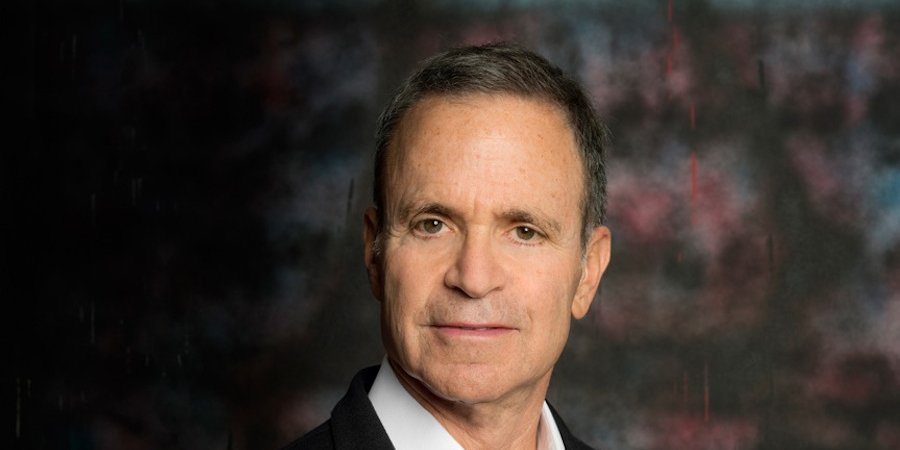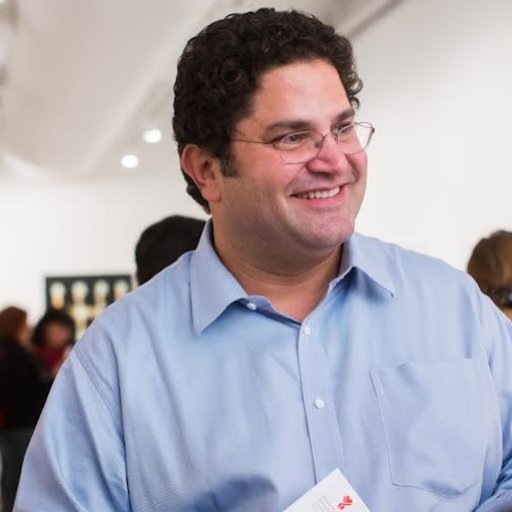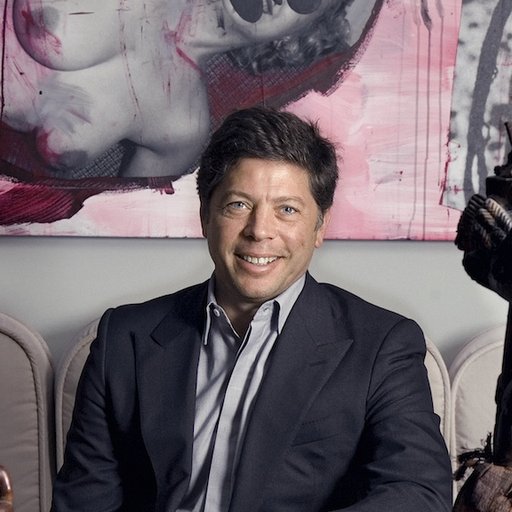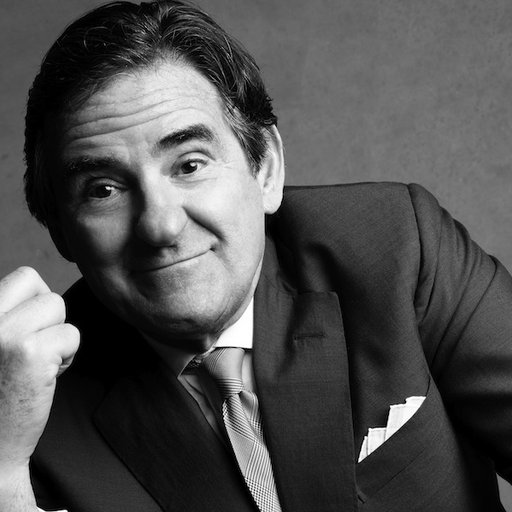New York City is home to some of the most energetic collectors of art, many of whom fill their homes to the brim with continually expanding holdings of paintings, sculptures, and works across the spectrum of media. Oftentimes, to avert a high-class Collyer brothers-type situation, these collectors send copious tranches of their art into storage. But one such collector, the real estate magnate Steven Guttman, was unsatisfied with the storage options available in the city. What did he do? He decided to build a state-of-the-art storage facility in Long Island City, funneling $70 million into making the project the preeminent operation of its kind in the world. He called it UOVO, after the Italian for "egg," in allusion to the fragility of the business's priceless cargo.
With the space about to have its grand opening this fall, collectors have been curious about UOVO's offerings. Artspace editor-in-chief Andrew M. Goldstein sat down with Guttman to find out about how the new enterprise functions, and to talk about the entrepreneur's own deep engagement with collecting contemporary art, which he pursues alongside his wife, Kathy.
You are currently building a gigantic, cutting-edge art-storage facility in Long Island City. What drew you to undertake such an immense project, and how did you choose the location?
Well, it started about a decade ago with my own need for space for my collection, and not being satisfied with the available space that existed. As a real-estate developer, I decided that this was a need that should be addressed. So eight years ago we built a relatively small facility—not anywhere near the scale we’re doing now—in the South Bronx, and now it's 110 percent occupied, without a single empty room. And we have a lot of satisfied customers. So we thought it was time to look for a really major art-storage facility, and we wanted to position it geographically so it would appeal to all of Manhattan. After scouting locations, it seemed that Long Island City was the most convenient, only two subway stops from the city—it’s close to Chelsea, it's close to the Upper East Side, and it's obviously close to Midtown. So that's where we chose to build.
The building is immense, and with a design that splits in into two components. Why is that?
It’s actually two buildings side-by-side, not one building. It's for insurance reasons—insurance companies don’t want too much art in one place. So there's a separation between the two buildings, and, to best to my knowledge, there isn't anything like it anywhere in the world.
How do you mean?
In terms of the overall scope of the project. There are some freeports that are nicely designed, but they're nowhere near the size of what we're building. And you can’t compare an older facility that’s been in rehab with a new state-of-the-art plan. We had the best museum-storage specialist in the world, the person who designed MoMA's art storage, help us design the specs. The first thing you look at with storage is whether there's dock space available, because if you look at some of the existing facilities they only have one or two loading docks. We have nine loading docks, and they're all enclosed, which means that the truck actually pulls into the space so you can close the door behind it and recondition, so don’t have any bad air coming in.
Then we’re going to have six viewing rooms, which is unheard of. I don’t know of any art storage facility in the New York area that has more than two, and if they have two they’re not big ones. We have six, and the biggest one is 40 feet by 40 feet and 20 feet high. You can put a major piece of art in there and look at it without any problems.
Ever since Hurricane Sandy, flood damage has become a much more pressing concern for collectors in New York City—and some of the older facilities storage experienced damage. What kind of precautions have you built into UOVO?
Well, we have eight floors in one building and six floors in another, and our first floor alone is 18 feet above sea level. So that’s not even an issue. At all. Plus this is an all-concrete-and-steel structure. If you have an older facility, chances are there are wood joints between the floors. So we're much safer when it comes to possible calamities—it’s totally climate controlled, we have protection against insects, we didn't cut any precautions. There was never a value of engineering process in this project. We just moved forward and did the best facility we can, because we think the New York market wants it. I mean, if you're a serious collector in New York City, you want the best home you can find for your art. At least I want that for my art.
You're an excellent spokesperson for your company, because, like the Hair Club for Men line, you’re not only the president, you’re also a client. What was your experience with art storage prior to starting your business?
My experience was as a customer, and I saw that there wasn't decent space available for storage. I tried to rent a room and I couldn't find one, and when I saw what might be available down the road, the spaces just didn't make sense to me. They're very old buildings that have been converted—they don’t have any of the features we have. So now, if you're a serious collector—and there are a lot of serious collectors out there—what we’re offering is simply far superior to what else is out there, and our rates are in line with the market. We’re not way over the market.
We also just acquired a second facility 20 miles away from New York City that's in a 100,000-square-foot building with 20-foot ceilings and seven fully enclosed loading docks. If it weren't for our facility in Long Island City, this second facility in Rockland County would be the best facility there is in the market for art storage, because it has everything you're looking for and it’s very efficient.
Why two facilities?
If you're a collector and you have some pieces you want ready access that are stored in the absolute best possible conditions, with your own viewing room, then you want to be in our facility in Long Island City. But you may have some pieces in crates, or sizable sculptures, that you simply want to put in longer-term storage someplace that’s not as expensive. So we can also handle that business as well. Our pitch is that not only do we have the best spaces, but there's a very good chance that we can save collectors money, because when you combine the blended rate between our two facilities, we’re going to be very competitive. So, it’s not going to cost you any more; it may cost you less.
There are a number of other storage facilities in the city, like Crozier. What is the competition in the field like?
There’s a lot of people in this business, but the way most of those companies started was that they were movers who would move art, and then people would say, "I can’t use this painting right now, can you just put it someplace for me?" So, over time, they ended up with all this storage space it became their business. But it all started with moving and logistics, and no one has ever stepped back and said, "How can we approach this a different way to be the best facility we can be." No one has ever approached this starting with the real estate.
I assume you're going to handle logistics as well?
We have to—that's all part of it. We’re going to have three trucks, and we're going to provide different services geared to different needs. For example, if galleries want a daily shuttle to the facility, we're going to have a daily shuttle from Chelsea. We wrap that all into the rent, together with how many days per year they want in the viewing room and things like that.
Can you talk a little bit about the kind of security you're going to have?
We have really good stuff. It's state-of-the-art security—that’s the best way to answer that. And our head of logistics is Amber Bonadio, who was previously head of logistics for Bonhams Auction House and before that was in the Navy, in charge of securing battleships. So she understands security. We have a great team of people. We also have Tom Hale, who was at White Cube and ran their whole storage and installation department, and they have 50,000 square feet of storage.
Our goal is to have the best people, the best benefits, the best of everything. It’s easy for us to have the best facility, because that’s just a matter of spending money to have it be the best facility you can have. To have the best logistical setup is something that takes fine-tuning—it's like opening a restaurant. You have to work through the kinks in order to have the best service. We've taken the time to get the right people and the right benefits.
How many artworks does a typical collector have in their collection when the need for art storage arises?
There’s a whole wide spectrum. We have some customers who need to put only one painting in storage.
And that’s a possibility?
Yeah, we can do that. We have what we call open storage where somebody can store one piece of art, or five pieces of art. They either just don’t want to sell, or, as is more common today, people are buying because for investment and want to store it safely. Or they may love an artist and decide not to hang a piece right then because they want to go deeper into this artist. So we can accommodate collectors across the spectrum, from people who want to store five pieces of art to somebody who has a 10,000-square-foot collection and wants their own personal viewing room, a work room, maybe even a full-time person working in there. We can also accommodate that.
For that latter customer, do you have a space suitable for that already or would you build it out specifically for them?
No, we custom-build—we're at the point now where we can build out specific spaces for people.
How many collectors would you say are in the vicinity of New York who are in the market for your kind of services?
That's a hard number to pin down, and it’s a changing number. And we talk about collectors, but there are all kinds of other customers too—there are foundations, there are museums, there are artists, there are estates. But nobody has the exact number of how many collectors there are, because it’s changing. After an auction there can be 15 new people needing storage. And anyway, art, as you know, is an expanding marketplace with growing interest and growing demand, and there's more art being produced every day so there's going be more need for storage over time.
Particularly with the rise of the speculative, investment-oriented collector, there must be a growing number of people who buy art in bulk and put it directly into storage.
There are some people who do that. But we also know a lot of serious collectors who don’t want to store anything—if they can’t hang it, they’re not going to buy it, or they'll sell something else to make room for it. So it depends on the collector. Everyone has different objectives.
What is your own approach to storage as a collector?
I’m the type of collector who is going to need storage. I live in Paris and do business there, so I have storage in Paris, and I live in New York and do business here, so I have storage here.
How many pieces would you say are in your collection?
It depends on what you include, but I would say about 500.
How did you start collecting?
Well, some people are just born collectors. As for me, it’s kind of a sad story. I started when I was going to law school in Washington, D.C, and there were two main galleries at the time that I really liked. One was Harry Lunn, and the other was Max Protetch. Harry Lunn was the first real photography dealer in the world, there wasn't any market for photography back then; that’s how old I am. So he's a legend among photography dealers, he had the best possible artists, and he couldn't sell a piece for over $100.
Anyway, I would go into his gallery twice a week, and I loved it, but I never bought a single thing from him because I was this hippie-looking kid wearing blue jeans and he always ignored me. Then with Max Protetch, we became friendly, and at the time he was showing Andy Warhol, Sol LeWitt, Donald Judd—all the great artists of that era. This was 1969, 1970.
Did you buy that work?
I looked at it, but I didn’t really get it. I didn't live in New York, remember? I lived in Washington, and Washington at that time didn’t help me develop a sophisticated taste because I didn't have any frame of reference. In terms of museums at the time, the Phillips Collection was Impressionist art, the East Wing wasn’t built then, and the Hirschhorn wasn't open. Anyway, to make a long story short, I didn't buy any of the pieces I should have bought. I started collecting English furniture as much as anything, and then I began buying contemporary art, mostly from Max, but I bought the wrong things. I bought the local Washington artists. And not even Kenneth Noland or Morris Louis—they were beyond my price point. And meanwhile, the Donald Judds and Andy Warhols were within my price range.
But you didn't get them.
I wasn't smart.
How did your interest in combining art and real estate emerge?
At the time I was actually interested in architectural law, so I went to law school, and then I decided I wanted to go into real estate development because I was wanted to build buildings. I was really more interested in the design of buildings than anything else, and I knew that by being a developer I could dictate the design better than even the architect could, because the architect just executes for the developer. So I ended up going into the shopping-center business, and we built some well-designed shopping centers. That got me to where I am today.
When do you think it was that you began to hit your stride as a collector?
I’m not sure I have yet. I’m serious. I don’t consider myself a great collector of art, though I think I hit my stride as a collector of design and furniture. I have much more confidence in that than I do as a contemporary art collector. I mean, I love contemporary art, but contemporary art is such a hugely diverse subject and I don’t feel I spend the time on that necessary to be a great collector. I’m working, and art really is a full-time thing. The people who do it full-time make the best decisions.
Do you work with an art advisor?
That’s a good question. I’ve worked with a few advisors, but I don’t think I’m a good client for art advisors because I’m too independent—I think too much for myself. I mean, I’m sure that there is an art advisor out there that I would do great with, but I haven’t met that person yet. And I don’t like frustrating people, so I don’t really want to engage. Another question is, how much more do I want to collect? I have a lot in storage already. I haven’t figured that out. But I’m still buying by the way. I bought three pieces at Frieze in New York.
What did you get at Frieze—a fair, not so incidentally, that UOVO was a sponsor of?
I bought an Analia Saban from Tanya Bonakdar. I just like her work.
What are some of your favorite pieces you've collected?
Well, it goes through periods, and we like showing things that we’ve kind of discovered. For example, we have Jean Royère chairs here in the living room, and we have another set in Miami with a sofa. We bought them about eight or nine years ago before Royère was widely known, and now they're iconic and go for a ton of money. We want iconic pieces, and we just love those chairs.
When something becomes so iconic and valuable, does it make it more nerve-wracking to use it as everyday furniture?
No, I guess that's not something I react to. But really, it's actually most exciting for me to have someone come in without being able to recognize anything and say, "Who did this? Who did that? And who did that?" Then I can say, "That’s a Rosemarie Trockel, that's an Arlene Shechet, that's a Jim Campbell." I’d really rather someone come in and not know a thing, because that’s my opportunity to be an artist. It’s just that simple.
Otherwise the story is already told.
That’s the only thing that I, as a collector, have a chance to provide. And it shows off my own curatorial skills. You mentioned when you came in that a photograph looked nice with that collection of ceramics. That’s my curation. So anyone can go out and buy a Picasso, and that’s fine. That’s great. But for me as a collector, curating less familiar art is where the art part comes out. Because we're in New York and in the art storage business, we move things around in this house so much it’s crazy. Every six months, something will be different. And we just redid our whole Miami Beach apartment—it was so much fun, because it’s a chance to rethink things. You may take something from storage that you haven’t seen for five years and put something else away, so you can rediscover things. We think, "Should we rehang that? Should we hang this?" That’s the fun part for us.
Speaking of curation, you're on the executive committee of the Pompidou, and until recently you were on the Miami Art Museum's board of trustees. What happened there?
I’m no longer involved with the Miami Art Museum. I was on the board of trustees, but when they renamed the museum [as the Pérez Art Museum, after donor and board member Jorge Pérez] I decided it wasn't the best decision and I didn't want to be part of it. I liked the idea of the Miami Art Museum. So now I’m the chairman of the American Friends of the Centre Pompidou Foundation, and I’m involved with the Whitney a little bit, as part of the chairman's circle. It's a step below the board.
What does it mean to be the chairman of the American Friends of the Centre Pompidou Foundation?
It means that I’m in charge of garnering enthusiasm and support for the Pompidou’s effort to amass a great collection of contemporary American art. That’s our mission, and we’ve been very successful. Last year we acquired over $3 million worth of art. We got a huge Mark Bradford painting, for instance, and we bought a series of Erin Shirreff photographs.
You've given a number of major artworks to the Pompidou yourself, is that right?
Yes, about seven pieces. I just gave a Cheyney Thompson to the Pompidou, the biggest one he’s ever done. They’re going to be installing it in their next show.
Do you collect his work as well?
No. I like his work a lot, but the Pompidou really wanted it in their show. So we bought it for them.
How do you determine what art you display, what you put in storage, and what you give to the Pompidou?
Well, number one the Pompidou has to want it. And then, sometimes, it’s kind of arbitrary. I just bought a huge Alex Israel painting two years ago, one of his backgrounds, and no one had even heard of Alex Israel then. I thought this would be a great painting for a museum, and I knew I could never hang it because it’s too big for our houses. So I bought it and put it in storage, and I offered the Pompidou and they said, no, they didn’t want it. Then a new director [Bernard Blistène] came in to replace Alfred Pacquement, and he said, "Yeah, we’d love to have that piece." Meanwhile, an Alex Israel went to auction this May for over a million dollars. It’s the same exact piece I have.
The museum must be very happy.
Museums don’t think about money. They think about value—at least this one does. Every museum is different, I guess, but, generally, if you're a great curator you're thinking about art and where an artist is in the history and evolution of art, who they've influenced and what their legacy is. I don't always understand it—I think in terms of dollars more than curators do.
One common lament among the observers of the major contemporary art auctions, which brought in $1.5 billion recently in New York, is that masterpieces that sell for spectacular prices all too often go directly into storage, where they are unseen for years. It's been reported that that Nahmad family, for instance, doesn't even pick up their artworks at the auction houses but leaves it with their storage facilities to await be resold some years later at a propitious market moment. How do you think about this phenomenon vis-à-vis the broader art-loving public?
I haven’t thought about it as much as maybe I should have, but I think it depends on the artist. If you're talking about something by an artist like Rebecca Quaytman, who does so little work, I think it’s a real shame. If it’s a Damien Hirst, who does so much work and has 140 people working for him, it’s not so much of a shame. That’s definitely my gut reaction. Certainly, if an artist has such limited output, it’s nice to have their work more accessible.
But, also, if an artist is in enough demand, they can dictate where the art goes. In other words, Mark Bradford is being very particular right now—and certainly, he can afford to be. He wants his pieces in museums, and for someone to be allowed to buy a piece, they also have to promise to donate it to a museum, generally.
Do you often collect according to those kinds of terms?
Yeah. There are things that galleries wouldn’t sell to me if they weren't promised gifts. In some cases, that means I get to keep it for my lifetime, but that doesn't mean I will. I mean, if I de-install something like that, I’ll just give it to the Pompidou—I’m not going to put it in storage if the Pompidou will take it. I bought a Quaytman a while back, and I wasn't going to buy it if it wasn't going to be a promised gift. So in fact that Quaytman is going to be installed at the Pompidou in January of next year. That makes me feel good, giving—I’m helping that artist get into the Pompidou. I think as a collector, anytime there's an opportunity to get a piece exhibited in a museum, we’re obviously willing to do whatever we can.



























